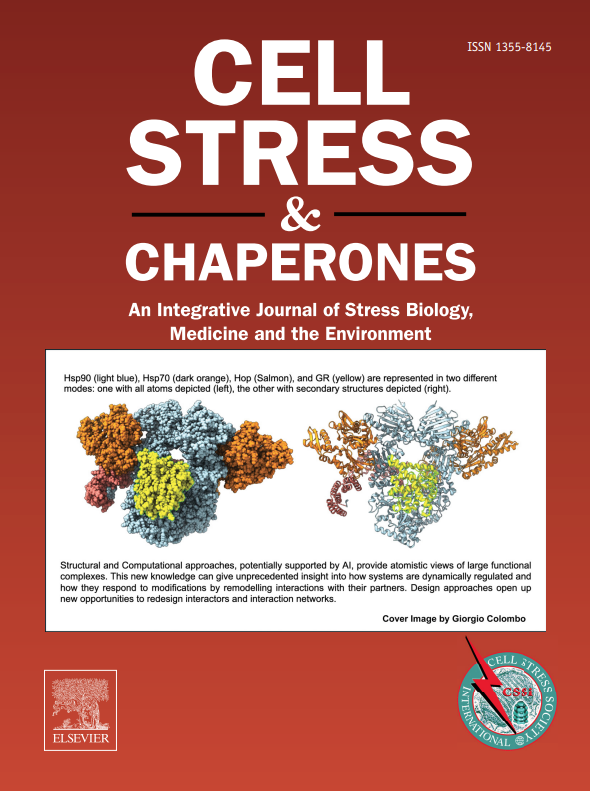UBL/BAG-domain共伴侣在过表达时会通过组成型激活Hsf1造成细胞压力。
IF 3.2
3区 生物学
Q3 CELL BIOLOGY
引用次数: 0
摘要
由于暴露于压力条件、突变或合成过程中的缺陷,细胞蛋白质很容易发生折叠错误。为了应对这种部分变性的蛋白质,细胞会启动一种由 Hsf1 转录因子参与的调节性转录反应,从而驱动分子伴侣蛋白和其他应激缓解蛋白的合成。在这里,我们发现裂殖酵母中人类 BAG-1、Bag101 和 Bag102 的直向同源物是与 26S 蛋白酶体结合的 Hsp70 共伴侣蛋白。只有包括 Ssa1、Ssa2 和 Sks2 在内的 Hsp70 型伴侣蛋白的一个亚群能与 Bag101 和 Bag102 结合,并且确定了与 Bag101 和 Bag102 相互作用所需的 Hsp70 ATPase 结构域中的关键残基。在人类中,BAG-1 的过表达通常出现在癌症中。在裂殖酵母中,过量表达 bag101 和 bag102 会引发 Hsp70 释放并激活 Hsf1 转录因子,从而导致强烈的生长缺陷。因此,在含有少量 Hsf1 的菌株中,与 bag101 相关的生长缺陷会得到缓解,而在 hsp70 缺失的菌株中则会加剧。总之,我们认为裂殖酵母的 UBL/BAG 蛋白会从 Hsp70 中释放 Hsf1,从而导致组成型 Hsf1 激活和生长缺陷。本文章由计算机程序翻译,如有差异,请以英文原文为准。
UBL/BAG-domain co-chaperones cause cellular stress upon overexpression through constitutive activation of Hsf1
As a result of exposure to stress conditions, mutations, or defects during synthesis, cellular proteins are prone to misfold. To cope with such partially denatured proteins, cells mount a regulated transcriptional response involving the Hsf1 transcription factor, which drives the synthesis of molecular chaperones and other stress-relieving proteins. Here, we show that the fission yeast Schizosaccharomyces pombe orthologues of human BAG-1, Bag101, and Bag102, are Hsp70 co-chaperones that associate with 26S proteasomes. Only a subgroup of Hsp70-type chaperones, including Ssa1, Ssa2, and Sks2, binds Bag101 and Bag102 and key residues in the Hsp70 ATPase domains, required for interaction with Bag101 and Bag102, were identified. In humans, BAG-1 overexpression is typically observed in cancers. Overexpression of bag101 and bag102 in fission yeast leads to a strong growth defect caused by triggering Hsp70 to release and activate the Hsf1 transcription factor. Accordingly, the bag101-linked growth defect is alleviated in strains containing a reduced amount of Hsf1 but aggravated in hsp70 deletion strains. In conclusion, we propose that the fission yeast UBL/BAG proteins release Hsf1 from Hsp70, leading to constitutive Hsf1 activation and growth defects.
求助全文
通过发布文献求助,成功后即可免费获取论文全文。
去求助
来源期刊

Cell Stress & Chaperones
生物-细胞生物学
CiteScore
7.60
自引率
2.60%
发文量
59
审稿时长
6-12 weeks
期刊介绍:
Cell Stress and Chaperones is an integrative journal that bridges the gap between laboratory model systems and natural populations. The journal captures the eclectic spirit of the cellular stress response field in a single, concentrated source of current information. Major emphasis is placed on the effects of climate change on individual species in the natural environment and their capacity to adapt. This emphasis expands our focus on stress biology and medicine by linking climate change effects to research on cellular stress responses of animals, micro-organisms and plants.
 求助内容:
求助内容: 应助结果提醒方式:
应助结果提醒方式:


